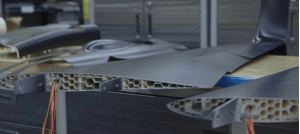Editor Notes : “According to Dan Campbell (pictured) from Aurora Flight Sciences, the new UAV is believed to be the largest, fastest, and most complex 3D-printed aircraft ever produced.”
By Aaron Heinrich,
3D printing just hit another benchmark, with the recent announcement by Aurora Flight Sciences and Stratasys Ltd that they have developed a 3D-printed, jet-powered unmanned aerial vehicle (UAV) with the ability to reach speeds of up to 150 mph (241 km/h). Unveiled at this week’s Dubai Airshow, it is reportedly the largest and most complex UAV ever created using 3D printing.
The high-speed aircraft, designed by Aurora and manufactured and assembled by Stratasys, has a wingspan of 9 feet (3 m) and weighs only 33 lb (15 kg). Over 80 percent of it was created using a 3D-printing process called Fused Deposition Modeling (FDM) that allows for the production of large yet lightweight objects.
 The fuselage itself was made of nylon, while the engine exhaust duct was 3D-printed in metal to withstand the high heat generated in that area of the aircraft.
The fuselage itself was made of nylon, while the engine exhaust duct was 3D-printed in metal to withstand the high heat generated in that area of the aircraft.
Both companies said the main goal of the project was to illustrate that it was possible to quickly go from designing to manufacturing to flying a lightweight, jet-powered aircraft. The longest print time was for the center-body fuselage, which Stratasys said took about nine days to create. All of the rest of the components – wings, nozzle, fuel tank and other small parts – were manufactured concurrently and took anywhere from a few days to a few hours to complete.
A little more than a month was spent on the initial integration, assembly and testing. Stratasys said that with all of the integration elements now worked out, it could build a second one in two to three weeks from start to finish.
This is not the first UAV to be created via 3D printing. In April 2014, University of Sheffield’s Advanced Manufacturing Research Center (AMRC) made a 3D-printed UAV airframe that could be printed and in the air within a single day. Later in October of the same year, they added electric motors that could propel the craft at speeds of up to 45 mph. Stratasys and a team from Boeing were involved in that project.
Here’s a short video that explains the Aurora and Stratasys jet-powered UAV project.

